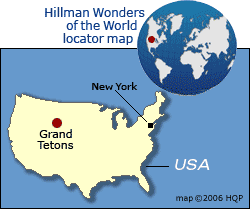Grand Tetons
 Why
Grand Tetons
are special
Why
Grand Tetons
are specialThe snowcapped, jagged Grand Tetons in northwestern Wyoming in America are one of the world's most scenic mountain ranges.
Name
Many non-French-speaking tourists are unaware that French fur trappers named the range after a part of the female's anatomy.
Highest peak
The highest peak is 4198 meters (13,770 feet) high and is simply called the Grand Teton. It is clustered with other skyscraping summits (see photo). Locals call it by an even simpler name, "The Grand".
Valey-to-peak height
Although their maximum height is less than half that of Mount Everest, the Grand Tetons rise about 2200 meters (7,000 feet) sharply above the Jackson Hole Valley floor.
And, there are no foothills in the foreground to lessen the impact of their majestic presence and the seven reflecting lakes that lie at its feet.
Climbing
The peaks are a paradise for serious mountain climbers. Many come here to hone their skills before heading off to the Himalayas.
More Grand Tetons tips and insights
Wildlife
The park is known for more than just its mountains. It's rich in wildlife, including moose, elk, and both black and grizzly bears. Recreational activities include hiking, camping, bird watching, horseback riding, bicycling, boating, rafting, skiing and picture taking.
Origin
The Grand Tetons began forming 13 millions years ago when the earth's crust separated along a north-south geologic fault line. The western land mass rose, creating the 65-kilometer (40-mile) long Grand Tetons mountain range. The eastern side sank, creating Jackson Hole Valley.
Fault line
It is still active. The mountains will continue to slowly rise and Jackson Hole Valley (currently about 2100 meters or 6800 feet high) will keep sinking.
Visitor count and location
Grand Teton National Park attracts 3 million visitors per year. It lies just minutes south of Yellowstone, a Hillman Wonder Gold Medal winner.
Location in America



